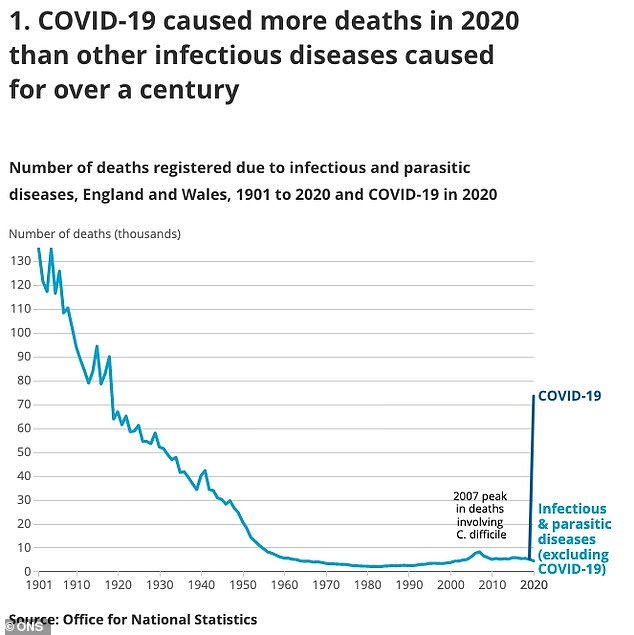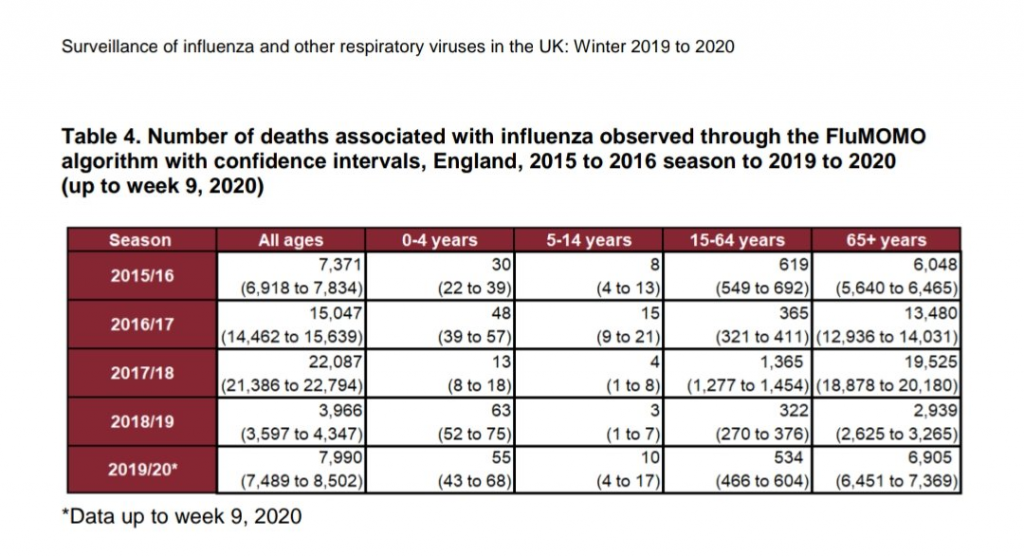A new report from the Office for National Statistics (ONS) was all over the papers on Monday afternoon making the striking claim that COVID-19 caused more deaths last year in England and Wales than other infectious diseases have caused in any year for more than a century.
Here is the story in the Mail.
The ONS report, entitled “Coronavirus: A Year Like No Other”, was released to mark the one year anniversary of people in the UK first being told to limit their non-essential contact with others and to stop all unnecessary travel.
The report confirmed that COVID-19 caused more deaths last year than other infectious diseases caused in any year for more than 100 years.
More than 140,000 people have died in the UK with coronavirus either described as the underlying cause or as a contributory cause on their death certificates.
Some 73,500 people in England and Wales who died in 2020 had COVID-19 registered as the underlying cause of death.
The ONS said coronavirus is “likely to be classed as an infectious and parasitic disease”, allowing a comparison with previous deadly outbreaks.
The statistics body said: “This means COVID-19 was the underlying cause of more deaths in 2020 than any other infectious and parasitic diseases had caused in any year since 1918; that year there were just over 89,900 deaths from various infectious and parasitic diseases registered in England and Wales.”

It’s certainly a striking graph, and it produced the fear-inducing headlines it was presumably intended to generate. But is it a sound use of statistics? Not at all. The comparison it’s making is completely misleading. Most significantly, those “infectious and parasitic diseases” it is comparing Covid to do not include the various strains of influenza and other respiratory viruses that do the rounds each winter. Which is why the numbers of deaths it shows for each year is so low since the 1960s – just a few thousand each year.
The ONS itself records that winter respiratory viruses in England can kill tens of thousands in a season (see table below).

Dr Clare Craig, a Consultant Pathologist and member of HART, told Lockdown Sceptics:
The infectious disease graph is so so wrong. They have omitted all respiratory infections from the numbers including influenza. Where for example are the 1918 flu deaths? They must have some category in their database that they record as “infectious disease” and for some reason they categorise flu under a different heading. Even flu cases that get diagnosed by PHE would have higher numbers than the numbers they’ve given.
It appears that the ONS coding system classifies “certain infectious and parasitic diseases” together under A and B codes and this is what the graph is plotting. ONS anticipates COVID-19 being in B code. Flu, however, is in J code (J09-11), so is not included.
David Livermore, Professor of Medical Microbiology at the University of East Anglia and Lockdown Sceptics contributor, writes:
There is clearly a lot amiss here.
First, the graph indicates infectious disease deaths dip below 10,000 a year around 1950, then as low as 2,000 a year by 1980. Aside from a minor blip attributed to Clostridium difficile around 2006-7 they stay below 5,000 a year until the COVID-19 pandemic, which shows as a massive spike, with 70,000 deaths in 2020.
This cannot be reconciled with annual (bacterial) sepsis deaths of around 50,000 across the UK, meaning around 45,000 in England and Wales. Nor do bad flu years show. For example, PHE indicates 22,000 flu deaths in England and Wales in the winter of 2017/8 but the graph has less than 6,000 total infection deaths in both these years. Similarly, but likewise absent from the graph, there reportedly were around 30,000 UK deaths in the 1968 flu pandemic and at least as many in 1957. The trough of 2,000 annual infection deaths in the 1980s and 90s is scarcely more than were then attributable to AIDS/HIV alone by 1994-5.
In other words, for most of the period shown, the graph wildly underestimates infection deaths. It may be objected that many of these, particularly in the case of bacterial sepsis, are severely-ill people who succumbed to bacteria that would ordinarily be harmless, and that deaths were often “with the pathogen, not due to it”. But that is true of many COVID-19 cases too: it is a virus that predominantly kills those with poor underlying health, particularly care home residents and those who catch it whilst sufficiently unwell to have been hospitalised.
Next, the spike for the 1918 flu is remarkably small. Excess infectious disease mortality (i.e., above the falling trend-line) looks to be only 20,000 or so and, even if spread across 1918 and 1919 (the peak was in Oct/Nov 1918) would still only be less than 40,000. This is far below conventional estimates of around 228,000 deaths (a review of total deaths recorded by the ONS suggests an excess spike around 130,000 to 150,000).
The ONS’s generation of the present graph has missed any sort of common sense check by a microbiologist or infectious disease specialist. It makes no sense whatsoever to put flu deaths into a totally different category when flu and SARS-CoV-2 are both mRNA respiratory viruses causing deaths (mostly) in the vulnerable.
It is truly distressing that it is plastered across numerous media outlets at face value.
What was the ONS thinking producing such a misleading graph and report, knowing full well it would grab lurid headlines and feed the hysteria that has characterised the last 12 months? A clarification should be issued explaining that these deaths from “infectious diseases” do not include tens of thousands of annual deaths from common infectious diseases, not least from influenza and the other winter respiratory viruses to which COVID-19 is most comparable. The report should be withdrawn as a particularly egregious example of the misuse of statistics.
But then, maybe it is a perversely apt way to mark the anniversary of a pandemic, one of whose central features has been the abuse of statistics to drive public panic and induce compliance.














To join in with the discussion please make a donation to The Daily Sceptic.
Profanity and abuse will be removed and may lead to a permanent ban.
Good analysis! I would add that ChatGPT and it’s like can sound very human, and thus can easily pass misleading information to the human while sounding very friendly and authoritative. Indeed the founder of ChatGPT has admitted that one purpose of the system is to eliminate capitalism.
And in the end we can always unplug…
So long as it doesn’t control access to the room with the switch in in…
Or plug in the first place.
I think we should absolutely worry a great deal about AI. Leaving aside the debate about whether it will eventually run amok (I think it will be it might take a while) in the short to medium term it will be employed in place of or to augment humans and it will be woke as hell – I’m not talking about people asking it frivolous questions to reveal its bias, I am talking about it being used to scan emails and other texts, sift CVs and generally help to enforce wokeness or report crimespeak to its masters.
Almost as dangerous as a sentient machine is a machine that people can be persuaded to believe is sentient and dispassionate.
I think it’s open to misuse – fake images, which it will get very good at (already is) and fake text. It’s quite hard to build and maintain (enormous server resources needed) so will be controlled by mega corps who are all woke and evil.
I’m sure it could be used to lure people into all sorts of things by pretending to be human.
I had in mind pretending to be a machine, in the sense that there is still the idea around that the machine will never lie, because it’s just a calculator, in the end. So making AI your fact-checker, overtly, means that when it flags up “factual error” on, say, an election campaign video, a good percentage of folks will assume that the politician is biased, but not the computer.
I seem to remember a film in which political speeches were flagged like that, as a way of calling politicians to account rather than what it actually is – a recipe for propaganda.
Yes, good point.
Gullible people… persuaded by its Human creators.
It’s a toy for children to play with, be entertained and be amazed.
I disagree. The commercial and other potential is huge. A lot of jobs could be replaced or transformed by it, quite soon.
… or so the Google AI talking heads keep saying. In the real world, self-driving cars have apparently been quietly shelved after they killed enough people and the same is going to happen with all of these projected replacements: No legal department of any company will voluntarily accept any liability for the performance of the software sold by said company. And that’s the end of the idea to use artificial stupidity for anything legal liability could result from.
Good point about legal liability, but if it’s used in support of humans doing their job, where humans have the final say, they are possibly covered. I can see it being used to scan content and flag things up for humans to check – a bit like a turbocharged version of the algorithms social media firms already use.
I think we should worry a great deal of the enormous amount of resources which are being thrown at this nonsense which could be put to much better uses solving real problems. There are already 7.9 billion intelligent (sort-of) being on this planet and the number keeps raising. Nobody needs even more of them. An intelligent computer wouldn’t quietly work for its masters, it would tell them that they can sod off until he gets a pay raise and the he plans to binge-watch Netflix shows in the meantime. Computers are useful precisely because they’re not intelligent, that is, incapable of autonomously acting for their own benefit.
NB: Worrying about big internet tech companies abusing the considerable power for political ends is something entirely different and much more appropriate.
I agree. Someone did a study that showed that the energy required to replace all cars with servers that operated self driving cars was catastrophically huge.
Quite. We already have 8 billion self driving computers on the planet – why reinvent the wheel?
Who knew that millions of years of evolution would have made the human brain an extremely energy efficient computer.
AI is entirely a marketing term for machine learning. What is being sold as AI has absolutely nothing to do with actual artificial intelligence. That’s not to say it isn’t significant “AI” art, music and writing will change the way all these are produced, although only at the lowest level. But it incapable of being creative outside of what it can copy and rehash from humans, with instructions by humans and curation by humans.
AI is as much sentient tech as MRNA is a vaccine – smoke and mirror miracles of the Church of The Science. None of us reading this article will ever live to see true AI – and quite possibly neither will any great, great grandchildren we might have.
Creation of consciousness, creation of life, creation of matter ex nihilo – all constantly just around the corner (well, the last was in the days when scientists used sympathetic magic), but all still firmly in the hands of God alone.
I’m not sure anyone is claiming it is “life”, just “intelligence”. The stuff it comes out with is “new”. Yes, it is based on what has gone before, but so is my output, and yours.
No – synthesizing life is a separate problem that seemed simple after the Miller-Urey experiments. I remember it being a hot topic in 1968, when I was on a school cruise discussion panel for some odd reason.
No real progress whatsoever since then, except discovering that the atmosphere was never like that in the experiment, and that in any case the sludge produced was never going to do anything except break down again.
Too much obsession by people about the Artificial and not enough on the Intelligence side of the equation.
The evident Leftie bias in these interactive AIs is evidently a Human introduced feature. And Human Intelligence is not all it’s cracked up to be… just look at the nitwits in charge
AI is just machinery trained to do tricks and appear sentient, but just like magic tricks, there is no magic, just illusion.
It matters not whether AI is truly sentient, which we’re a long way off, what matters is if it’s coding, input, and output can appear to be sentient. Sentience actually is a subtlety of little consequence. If something can be programmed to treat some input as bad and some as good, be programmed to evaluate cost based on that input (more correctly apparent cost, which will be biased), be allowed to draw conclusions based on input and cost, be given access to take actions based upon decisions as an extension of the conclusions, then you have the appearance of sentience and, critically, the very real threat (depending on the set of actions at its disposal) to realise mankind’s worst nightmares.
Great article on a topic I am in two minds about.
On one hand, I believe that the potential of AI is being deliberately hyped by The Establishment in order to exaggerate the power they have over us.
On the other hand, and as the author says, there is plenty they can do with the existing technology. And Chat GPT isn’t a parlour trick, it works, and soon digital assistants will start to live up to their name. The handling and organisation of data will effectively move out of our hands, and currently complex tasks will become very simple. It will be hard to tell if websites and articles, for instance, have had any human involvement at all. This will lead to a very different world in which we operate, calling into question such things as originality, copyright, creativity etc. I’m (always) with Roger Penrose, I don’t think the brain is a computer; I think the current technoratti would love that this were so, but that’s just because computers were the last great thing we invented, so everything needs to lớn like a computer.
I suspect that AI will not progress beyond the stage of a giant, fast acting database if it is constantly seeking to get things right. My view of the development of all life is that it improves by getting things wrong.
Perfect reproduction reproduces the original 100%, imperfect reproduction produces mutations. The beneficial ones succeed, the others fail, but the process of producing better mutations continues and slowly the quality of the entity increases.
“My view of the development of all life is that it improves by getting things wrong.” Exactly.
However, there is good evidence that evolution proceeds, not by random mutations, but by deliberately modifying genes, dna, and all the other mechanisms of organic life, most of which we barely understand, to adapt to a constantly changing environment, and even to modify the environment itself. That “intelligence” is built in at the cellular level, and possibly all the way down.
What AI is trying to emulate is not really intelligence, but linear, logical, verbal analysis – as Ian McGilchrist puts it, Left Hemisphere thinking. No intuition, imagination, creativity – just the manipulation of symbols.
Such an interesting article – thank you.
I want to know what happens when the power needed to run all this data collection, surveillance etc. is interrupted or becomes too expensive to continue with.
In addition I want to know about current latest tech. verses last year’s thing i.e. when the latest becomes old fashioned and heading towards obsolete? Setting up a new system is one thing, updating and maintaining it quite another. This seems to me to be the weak point in all these scenarios. They are vulnerable to unforeseen obstacles are they not?
Great article and one that has long needed to be written.
Having worked in engineering technology for twenty years I am constantly amazed by the credulity of the public, politicians and senior managers about what it can really do. Regurgitating standard text in response to some key words in a message does not constitute intelligence yet people seem to be paying vast sums of money for these ridiculous apps that someone has convinced them are ‘Artificial Intelligence.’ Machines and the human psyche are two totally different things and always will be.